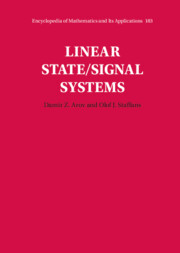Book contents
- Frontmatter
- Contents
- Preface
- Notations
- 1 Introduction and Overview
- 2 State/Signal Systems: Trajectories, Transformations, and Interconnections
- 3 State/Signal Systems: Dynamic and Frequency Domain Properties
- 4 Input/State/Output Representations
- 5 Input/State/Output Systems: Dynamic and Frequency Domain Properties
- 6 Bounded Input/State/Output Systems in Continuous and Discrete Time
- 7 Bounded Input/State/Output Systems in Continuous and Discrete Time
- 8 Semi-bounded Input/State/Output Systems
- 9 Semi-bounded State/Signal Systems
- 10 Resolvable Input/State/Output and State/Signal Nodes
- 11 Frequency Domain Input/State/Output Systems
- 12 Frequency Domain State/Signal Systems
- 13 Internally Well-Posed Systems
- 14 Well-Posed Input/State/Output Systems
- 15 Well-Posed State/Signal Systems
- Appendix A Operators and Analytic Vector Bundles in H-Spaces
- References
- Index
3 - State/Signal Systems: Dynamic and Frequency Domain Properties
Published online by Cambridge University Press: 05 May 2022
- Frontmatter
- Contents
- Preface
- Notations
- 1 Introduction and Overview
- 2 State/Signal Systems: Trajectories, Transformations, and Interconnections
- 3 State/Signal Systems: Dynamic and Frequency Domain Properties
- 4 Input/State/Output Representations
- 5 Input/State/Output Systems: Dynamic and Frequency Domain Properties
- 6 Bounded Input/State/Output Systems in Continuous and Discrete Time
- 7 Bounded Input/State/Output Systems in Continuous and Discrete Time
- 8 Semi-bounded Input/State/Output Systems
- 9 Semi-bounded State/Signal Systems
- 10 Resolvable Input/State/Output and State/Signal Nodes
- 11 Frequency Domain Input/State/Output Systems
- 12 Frequency Domain State/Signal Systems
- 13 Internally Well-Posed Systems
- 14 Well-Posed Input/State/Output Systems
- 15 Well-Posed State/Signal Systems
- Appendix A Operators and Analytic Vector Bundles in H-Spaces
- References
- Index
Summary
The concept of social licence is increasingly being used to draw attention to the need for community support and acceptance of research,particularly of data-based research. Chapter three examines the nature of social licence and its application to research using linked data. Social licence is framed as an analytical tool to design and evaluate decision making for sharing and using linked data for research. The chapter examines the qualitative evidence of public perceptions and the conditions for community support and identifies the substantive and procedural conditions that lead to trust and legitmacy. The chapter concludes that these conditions should be embedded in the governance of research using linked data to develop and sustain community acceptance.
- Type
- Chapter
- Information
- Linear State/Signal Systems , pp. 132 - 216Publisher: Cambridge University PressPrint publication year: 2022

